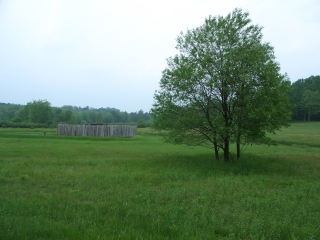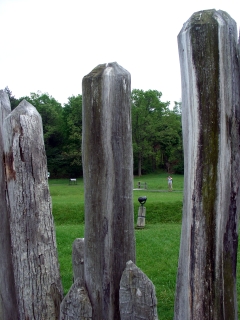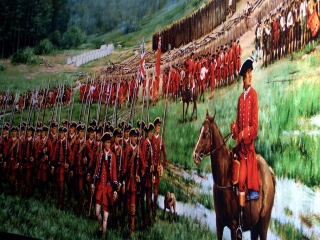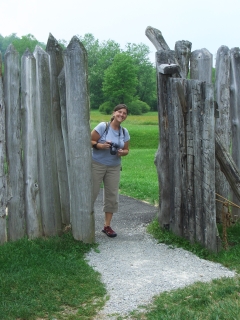NPS Website; Local Website
 WHAT IS IT?
WHAT IS IT?Site of the July 3, 1754 battle between British Colonial troops, led by a young George Washington, and a cunning band of Frenchmen led by a revenge seeking Captain whose brother had been killed by the British in a May 1754 skirmish known as the Jumonville Affair.
The Battle at Fort Necessity was the first battle in the Seven Years War, of whose North American theater is commonly known as the French and Indian War. The chronologically challenged War was fought from 1754-1763, involved all the major European powers, took place on four continents and was, in practice, the first world war.
The Site also commemorates the 1804-1818 construction of The National Road, the first terrestrial highway in the United States built with federal funds. The Road was our first Interstate. Today, US Route 40 follows a nearly identical route.
BEAUTY (4/10)
The Fort sits in a clearing among typical Western PA forested foothills, the same foothills that host 2 Frank Lloyd Wright homes and perennial white water rafters’ favorite, the Youghiogheny (yuck-kah-GEY-nee) River. Woodlands encroach the Fort less now than in Washington’s time. Well-placed signs indicate to the visitor where the original Fort’s manicured lawn used to end.
The Fort itself is reconstructed and smaller than we imagined. Spiked wooden stakes form a perfect circle around a small cabin inside. Not much room to maneuver to stave off the French and American Indians which France temporarily befriended.
HISTORICAL INTEREST (8/10)
In 1914, the Archduke Frank Ferdinand was famously murdered in the streets of Sarajevo, thus igniting the powder keg of Europe and plunging the world into The Great War.
One hundred sixty years earlier, a similarly fateful spark lit in the woods of southwestern Pennsylvania where an expeditionary force of British troops clashed with French troops, beginning the Seven Years War. When fighting ended in 1763, France ceded control of its North American colonies and the subcontinent of India to Great Britain.
 In 1754, the lands around Fort Necessity marked a territorial overlap claimed by Great Britain, France and tribes allied with the Iroquois nation. The first battle came in May, when a chance firefight ended in the death of French commander, Joseph de Coulon Jumonville. No one knows exactly what happened.
In 1754, the lands around Fort Necessity marked a territorial overlap claimed by Great Britain, France and tribes allied with the Iroquois nation. The first battle came in May, when a chance firefight ended in the death of French commander, Joseph de Coulon Jumonville. No one knows exactly what happened.The French claimed that Jumonville had been insidiously murdered after being taken prisoner by British commander George Washington. The British insisted that the Battle had been fought honorably and no such “assassinations” occurred. Tensions mounted and a large-scale battle was inevitable.
The ensuing July 3, 1754 fight proved anticlimactic. George Washington built Fort Necessity too close to the surrounding forest and on the tactically poor low land. The Fort was quickly overwhelmed by the French and Washington was forced to surrender.
The terms of surrender proved more interesting than the fight itself. The document, written in French, included an admission of Jumonville’s “assassination”. Washington, who could not read French, signed the document without an understanding of its terms. This was not a shining moment in George’s career. The Jumonville incident, the fight and the surrender terms quickly became sensational international news, giving a concrete reason for these rival nations to begin the Seven Years’ War.
CROWDS (7/10)
A brand new Visitor Center (opened October 2005) easily handles the hundreds of school kids that pass through its doors each year. The building was designed to facilitate heavy traffic with minimal impact on other visitors, something we appreciate. As do the Rangers, who rolled their eyes and shuddered at the thought of the claustrophobic former VC. It seems like we came at a good time.
EASE OF USE/ACCESS (3/5)
Fort Necessity is located along U.S. Route 40, the National Road, about 10 miles southeast of Uniontown, Pa. Modern-day Interstates, I-68, I-70, I-76 and I-79 all pass within 50 miles of the Site. I-68 is the closest, passing 15 miles to the south. If your trip involves connecting two of these roads then a rural detour to Fort Necessity could make a nice respite from the 18-wheeler convoys that characterize those highways.
CONCESSIONS/BOOKSTORE (4/5)
Fort Necessity NB’s bookstore was pretty good. Center bins were filled with inexpensive stuffs that school kids and Gab tend towards – tin whistles, puzzles with twisted iron pieces and those cuddly George Washington dolls. Michael found titles on regional tourism, the War of 1812 and probably the best selection of George Washington books we have seen. A Ranger was kind enough to recommend a few titles which gave a more global perspective on the Battle at Fort Necessity and the rest of the American skirmishes which fueled the fire of the Seven Years War.
We also caught our first glimpse of the garishly enormous Explorer Edition of the National Parks Passport Book, which is, in effect, a binder not a book. Ooof. We can’t imagine hauling that around.
 COSTS (2/5)
COSTS (2/5)A $5 entrance fee is good for 7 days. Entrance fees are waived for large groups on educational visits. We were relieved that although the VC, exhibits and film are all new, that Fort Necessity NB is not going the way of other national battlefields and charging “user fees.” Your National Parks Pass will work here.
RANGER/GUIDE TO TOURIST RATIO (5/5)
Rangers manned the front desk alongside Eastern National employees, guided the school groups and prepared themselves for a special costumed tour for an individual with medical issues while we were there. Two young seasonal Rangers in training shadowed the volunteer who gave the 2 pm Tavern tour. There were Rangers everywhere!
TOURS/CLASSES (8/10)
We were probably among the last visitors to view the illustrated-slides-transferred-to-DVD version of the Battle at Fort Necessity. While the film wasn’t bad, it wasn’t nearly as animated as the 10-minute “visit Laurel Highlands” promo that followed it. We missed the debut of the new Battle at Fort Necessity video, filmed the previous year entirely on location, by half a day.
We don’t know what the former exhibits looked like, but the new ones are excellent. Bright, easy to read timelines and maps cover the walls and explain a multi-faceted global event in digestible segments without ever dumbing down the content. We appreciated that the Site tried to give a context for the events at the Great Meadow and explored consequences beyond the North American continent.
Short film clips, timelines and memorabilia illustrate the construction of, and then cycles of heydeys, neglect and revivals of the National Road. Exhibits at Fort Necessity NB present the National Road as a physical manifestation of the state vs. federal responsibility and rights debate and offer a window into a young nation’s growing pains.
The 2 pm tour of Mount Washington Tavern didn’t add much to what we had already learned at the VC. The tour guide began by saying that the Tavern really had nothing to do with the Site and had no real historical relevance other than its position along the National Road. It didn’t take us long to slip away to take a self-guided tour of the Meadow and reconstructed Fort.
 FUN (8/10)
FUN (8/10)A very pleasant afternoon was had at Fort Necessity NB. We chatted with Rangers, dodged school kids, watched reënactors set up for their weekend programs, wandered the grounds and strolled through the still new smelling VC. We don’t know what a visit to Fort Necessity pre-October 2005 was like; they seem to have spent their money wisely.
Had we planned a little better, we could have chosen a course to the Site that would have taken us through the Ohiopyle SP and past at least one of the Frank Lloyd Wright homes. But our drive was scenic nonetheless.
WOULD WE RECOMMEND? (7/10)
While Fort Necessity is a recommended destination in its own right, it also benefits from its location in Fayette County and the Laurel Highlands region. Wright’s Kentuck Knob and Fallingwater and camping and rafting at the Ohiopyle State Park are all within short drives from the Site. Friendship Hill NHS is about an hour away. Historic sites, architectural landmarks and nature - there should be something there to suit all your traveling companions’ needs.
TOTAL 56/80
www.usa-c2c.com
© 2004-06